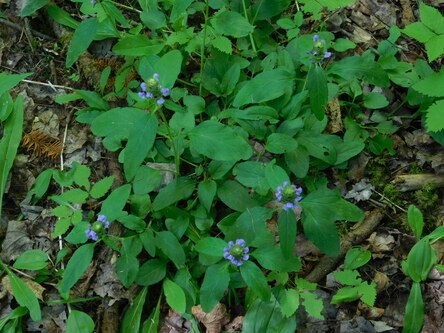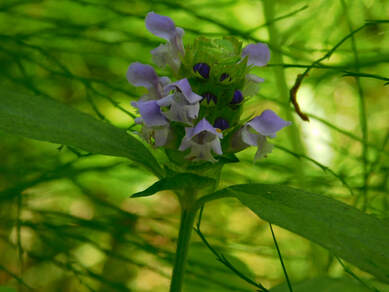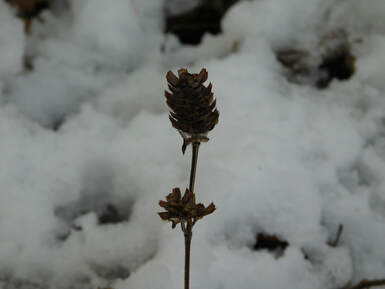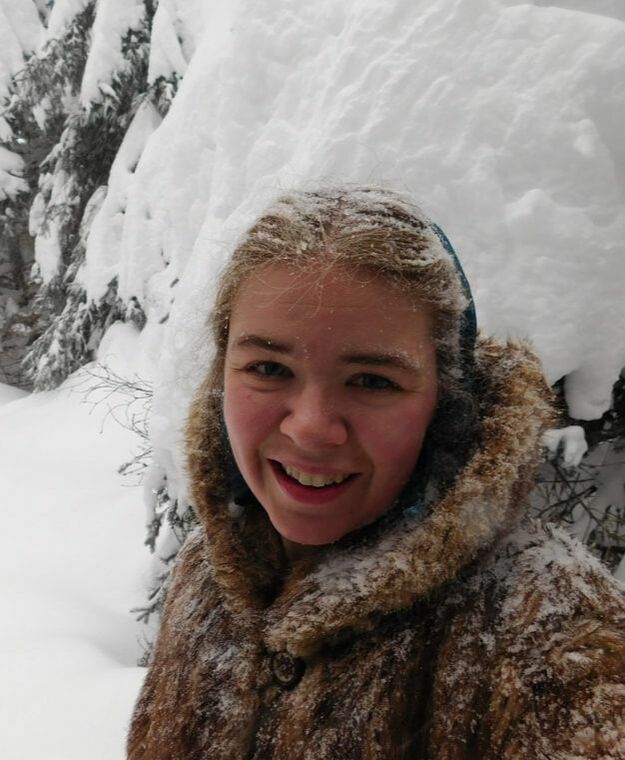"When little Elves have cut themselves,  Have you ever come across a plant whose identity was entirely unknown to you, and instinctively felt that it must have an interesting past? It has happened to me often, but the first plant that comes to mind is the beautiful Self-Heal (Prunella vulgaris). It may come as a surprise to some of you that I only made the acquaintance of this plant last summer, since to many it is a pesky lawn weed. It doesn't grow in our yard, however, and the first time I came across it was on a hot summer day's walk in the woods. I was struck by its unusual appearance and beauty and felt sure that I was not the first who had been so impressed, and that perhaps some great usefulness had been attributed to it by our ancestors. Of course, all that was confirmed when I learned its name! It was in fact considered almost a cure-all, and an old French proverb claims that no man will need a physician if he has this plant. Culpeper writes thus in his English Physician: "Self-Heal, whereby when you are hurt, you may heal yourself". Gerard praises its virtues highly, claiming that "there is not a better Wound herbe in the world than that of Selfe-Heale is". He also recommends it as a remedy for headaches: "Prunell bruised with oile of rose and vineger, and laid to the forepart of the head, swageth and helpeth the pain and aking thereof". I may try that one on myself sometime! It is still used by some modern herbalists and is believed to have anti-inflammatory and astringent properties. In A Modern Herbal, Mrs. Grieve writes: "An infusion of the herb, made from 1 oz. to a pint of boiling water, and taken in doses of a wineglassful, is considered a general strengthener. Sweetened with honey, it is good for a sore and relaxed throat or ulcerated mouth, for both of which purposes it also makes a good gargle. For internal bleeding and for piles, the infusion is also used as an injection". The genus name, Prunella, is actually a corruption of the German Brunella, or Brunellen, a name derived from its use to treat an inflammation of the throat and mouth which in German was called de Braune. James Britten's Dictionary of English Plant Names (1886) lists well over a dozen common names for this plant. Many of them are suggestive of its medicinal uses, such as Carpenter's Herb, Hook-Heal, Slough-Heal, and Touch-and-Heal. Another interesting name is Heart-of-the-Earth, "because it chiefly occurs in thin poor soils, where the farmer gives it the credit of eating away all the substance of the soil. It was apparently a somewhat troublesome weed in cornfields, from which it gets yet another name, Pick Pocket, although this name was a general one applied to several different plants that were considered troublesome. It has a few prettier names as well, such as Blue Curls, Bumble Bees, and London Bottles. Prunella vulgaris is a member of the mint family (Labiatae), native throughout Europe, Asia, and North America. It is interesting that several English writers claim that it was "one of those common wildflowers that have found their way to North America, tending even to oust the native flowers". Yet, according to all the modern sources I have seen (including the USDA) it is actually native here, and, at least in my area it seems to be quite unobtrusive.  I think the little Self-Heal is remarkably pretty, and many others have been of the same opinion. So, I was rather shocked yesterday when I read what the Victorian art critic, John Ruskin, had to say about it. Speaking of the mint family in general, while he does praise their usefulness and fragrances, he yet says that "there is scarcely a blossom of them which is not more or less grotesque, even to ugliness", and even goes so far as to suggest that they are distorted by some evil influence: "...it is not the normal character of a flower petal to have a cluster of bristles growing out of the middle of it, nor to be jagged at the edge into the likeness of a fanged fish's jaw, nor to be swollen or pouted into the likeness of a diseased gland in an animal's throat. A really uncorrupted flower suggests none but delightful images, and is like nothing but itself". Truly a strange theory! Yet even he admits that the Self-Heal was "a flower very dear and precious to me", and "the only flower left to be loved among the grass" after the early summer flowers had faded. He writes that "the most glowing violets could not be lovelier than each fine purple gleam of its hooded blossoms". But here his praises end and he complains, "But their flush is broken and oppressed by the dark calyces out of which they spring, and their utmost power in the field is only of a saddened amethystine lustre, subdued with furry brown. And what is worst in the victory of of the darker colour is the disorder of the scattered blossoms; - of all the flowers I know, this is the strangest, in the way that here and there, only in their cluster its bells rise or remain, and it always looks as if half of them had been shaken off, and the top of the cluster broken short away altogether". Looking yet closer (through a magnifying glass) he goes so far as to say that the form of the flowers is "grotesque beyond all wonder"! Well, Mr. Ruskin's ideas seem to be quite unlike any others I have come across, fortunately!  In my opinion it is lovely enough even for the flower garden, and surely a plant which has been so useful for centuries is under no "malefic influence"! The whole plant is quite interesting even in winter, "when the heads of dry calyces stand up like little brown turrets", and have given me much pleasure during my late fall rambles (before they were completely buried!). I would be delighted to learn what others think of this little flower! Do you consider it a weed or a wildflower? Have you ever used it medicinally? I am linking with Clay and Limestone today for Wildflower Wednesday!
16 Comments
1/23/2019 09:19:16 pm
Swageth and helpeth....I love it!! What an interesting little native. Seems like so many natives get a bum rap. This beauty seems to give an awful lot.
Reply
JanetLee
1/24/2019 09:36:02 pm
Lovely! To me they are wildflowers. Even those that most folks call weeds. I think they are all pretty and Mother Nature put them here for a reason.
Reply
Veleiria
1/25/2019 12:20:53 am
I don't have them here in north central Florida, but they are lovely. I have so many pretty little weeds in the pasture. I pick them and put in tiny vases to set on my window sills. Most are blues n yellows. I have heard my grandma speak of the Self-Heal plant. They must have them in Virginia, where she was from. Enjoy your blog so much. Oddly enough I came across it thru a knitting site I subscribe to called Knitting Paradise. A gal posts your URL. Happy hunting. V
Reply
Oooh, your little wildflower vases sound so lovely! And that is special that you heard from your grandma about the Self-Heal plant. I wish there were more people in my family I could learn from about plants. My grandma on my mom''s side was a flower lover but she passed away before I realized that I was! We would have so much to talk about now. Also, I just found out a couple years ago, after my uncle passed away, that he was quite the gardener. Sadly I never knew him very well.
Reply
That an interesting post Joanna, I found self heal growing in our 'lawn' back in 2017, I mowed round them: http://noellemace.blogspot.com/2017/07/in-vase-on-monday-raising-my-glass.html
Reply
I'm sure the bees appreciated your mowing around those lovely flowers! 😊 I wouldn't mind it in my yard at all, but it seems to prefer fields and roadsides here.
Reply
I enjoyed that little poem at the beginning of the post. I'm guessing I have seen this flower in the wild but gave it little mind since the flowers are not too showy. To me it looks like it would fit into a garden as an unobtrusive part of a mixed ground cover.
Reply
2/5/2019 02:40:58 pm
I wonder why Ruskin took so intensely against the little minty flowers?
Reply
Leave a Reply. |
AuthorI am a passionate gardener and seed-saver, who also enjoys playing the violin and accordion, running, spending time with my 4 golden retrievers, keeping chickens, photography, and reading. Archives
March 2019
|

 RSS Feed
RSS Feed
